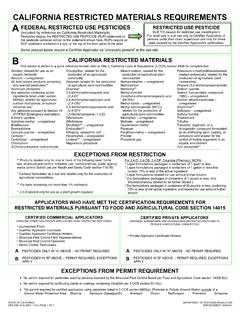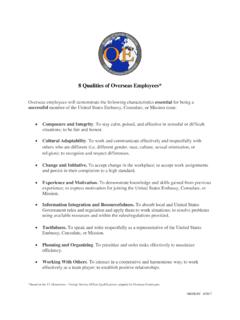Transcription of Improving health worker performance: in search of ...
1 Improving health worker performance: in search of promising practices A report by Marjolein Dieleman and Jan Willem Harnmeijer KIT Royal Tropical Institute The Netherlands Evidence and Information for Policy, Department of Human Resources for health Geneva, September 2006. Content Summary of lessons 1. Part 1 Factors influencing performance of health workers and strategies for 5. Performance of health workers: 5. 9. Productivity, competence and responsiveness .. 16. Lessons 26. Recommendations .. 30. Part 2. Case studies: examples of interventions to improve performance of health workers.
2 35. References .. 59. Annex 1. Terms of 65. Annex 2. A brief overview of theoretical concepts on motivation and job 67. Annex 3. Overview of indicators per case 69. Annex 4. HSRC/HRC 71. Improving health worker performance: in search of promising practices Page iii Improving health worker performance: in search of promising practices Page iv Abbreviations ARV antiretroviral GAVI Global Alliance for Vaccines and Immunization HIC high-income country HIV human immunodeficiency virus HIPC heavily indebted poor countries HMIS health management information system HR human resources HRD human resources development HRH human resources for health HRM human resources management ILO International Labour Organization IMF International Monetary Fund JLI Joint Learning Initiative LIC low-income country MDG Millennium Development Goals MoH ministry of health
3 OECD Organisation for Economic Co-operation and Development PI performance improvement QA quality assurance WHO World health Organization UNDP United Nations Development Programme Improving health worker performance: in search of promising practices Page v Improving health worker performance: in search of promising practices Page vi Summary of lessons learnt Background to the consultancy qualified and motivated human resources (HR) are essential for adequate health service provision, but HR. shortages have now reached critical levels in many resource-poor settings, especially in rural areas.
4 Strategies Improving performance are essential to address shortages of the existing workforce. In this report, performance is considered to be a combination of staff being available (retained and present) and staff being competent, productive and responsive (WHO, 2006). Approaches that are evidence-based will inform policy-makers as to which interventions are successful, under which circumstances, and for what groups of staff (Buchan, 2002), but little has been published on what works and what does not. This report was commissioned by WHO as a follow-up to the World health report 2006: Working together for health , to describe experiences and to provide lessons learnt with respect to interventions to retain staff and improve their productivity, competence and responsiveness.
5 It is primarily written for health policy- makers, planners and managers in resource-poor settings. Methodology A desk study was performed of published and grey material. Literature was searched by means of the databases of PubMed, Medline, Cochrane reviews and electronic journals, over the period 1996 2006. Relevant web sites were also consulted, such as those of international organizations and institutes involved in research or interventions in performance. Approximately 500 persons with HR experience were contacted. Initial findings Poor performance is a result of health staff not being sufficient in numbers, or not providing care according to standards, and not being responsive to the needs of the community and patients.
6 Various factors influencing staff retention and mobility can be distinguished: personal and lifestyle-related factors, including living circumstances;. work-related factors, related to preparation for work during pre-service education;. health -system related factors, such as human resources policy and planning;. job satisfaction, influenced by health facility factors, such as financial considerations, working conditions, management capacity and styles, professional advancement and safety at work. There is a wide range of reasons why health workers leave their jobs, and financial reasons are often not the only (or the main) reasons.
7 Factors are also likely to be interrelated and their influence on health providers depends on the political, socioeconomic and cultural environment. As causes for retention are likely to be rooted in both personal and work-related factors, strategies must address these multiple causes simultaneously. Interventions can take place at the macro or health -system level, such as HR policy and planning, rural recruitment and training and bonding. They can also take place at micro or facility level, aimed at Improving job satisfaction by addressing working conditions, providing incentives and offering professional development.
8 Interventions can also aim to improve the living conditions of individual workers, or address the needs of specific groups. The report includes case studies describing the experience gained in adopting these different strategies. When staff members available, their performance is determined by productivity, responsiveness and competence. These elements are influenced by absenteeism, motivation and job satisfaction, obtaining knowledge, skills and attitudes, accountability systems and working conditions, which in turn are all interrelated. Strategies to improve productivity, responsiveness and competences can be implemented at various levels.
9 Improving health worker performance: in search of promising practices At macro or health -system level, certain strategies within health sector reforms can be successful, such as changes in payment systems, decentralization, community participation and accountability mechanisms. At micro or facility level, tested strategies include quality assurance and performance-improvement interventions and activities in human resources management, such as performance-based incentives, supportive supervision, training and Improving leadership and management. Interventions to improve productivity, responsiveness and competences can also address the living conditions of health workers in rural areas or the needs of specific groups, such as female health workers or workers in specific age groups.
10 Cases at various levels, and addressing different issues, are all described in the report. Results As elements influencing performance are intricately related to each other, interventions must be comprehensive and multifaceted and must take place simultaneously and at different levels of the health system. While experiments have taken place using different types of interventions to improve performance of health workers, substantive evidence of their effectiveness is still limited. Nevertheless, a number of lessons can be learnt from the cases described in this report.
















